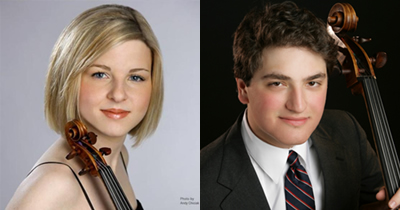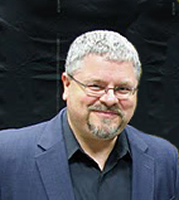Back problems forced the postponement of pianist Bella Davidovich’s scheduled appearances with the Greensboro Symphony Orchestra, so elements of a May 2005 program filled the void, and instead of an “All in the Family” evening with Davidovich and her son, Music Director Dimtry Sitkovetsky, he assumed a double role as conductor and violin soloist on October 21 in War Memorial Auditorium. His use of traditional European orchestral seating, with first violins and violas left of the podium and the second violins and cellos on the right, makes following complex musical lines and juxtapositions of instruments much easier.
Naturally-paced tempos that gave the music time to breathe characterized Sitkovetsky’s interpretation of the Concert Overture by Mendelssohn known as “The Hebrides” or “Fingal’s Cave.” The virtuoso’s deep understanding of strings was evident in the high standards of playing in all the sections; there was closely matched ensemble, secure intonation, and chamber music-like give-and-take. The woodwinds were strongly characterized, and there were good solos from Principal Oboist Cara Fish and Principal Clarinetist Kelly Burke. Principal Trumpet Anita Cirba also made telling contributions.
Mendelssohn’s Violin Concerto in E Minor, Op. 64, substituted for the scheduled Second Piano Concerto of Chopin, made a natural pairing with the opener. I admit to shuddering when I see this concerto or Bruch’s First programmed. Every young violinist, fresh off the conservatory conveyor belt, is scooted onto the concert stage with one or the other, and all too often what we hear is the sonic equivalent of a pressed flower, with every note in place but no life. There was nothing at all “pressed” about Sitkovetsky’s outing with the old war-horse; it was more like the excitement of a fast excursion on a curvy country road in a sports car with the top down. With much of his time taken up with the solo, Sitkovetsky could cue only sporadically, but Concertmaster John Fadial provided support, and the players listened carefully to each other. Thus elements of chance, combined with the seemingly relaxed insouciance with which Sitkovetsky attacked the exposed high notes, made for a very memorable “ride.” Had this been done for a recording, one or two places might have needed editing, but this was very much a “performance art piece,” experienced in real time.
Shostakovich’s masterful Symphony No. 10 in E Minor, Op. 93, composed in 1953, is the most challenging work that Sitkovetsky has programmed to date in Greensboro and one of the most significant scheduled anywhere in the state this season. The conductor quipped that it and he are about the same age before discussing his family’s close association with the composer’s music and noting that the composer’s presence in Moscow was “like having Beethoven walking about.” Because of Stalin’s tyranny, many of the composer’s deepest works were “put in a drawer” for safer times. Stalin died in March 1953 and the Tenth Symphony was composed during the summer and fall of that year. Through the long slow movement and the diverse demands of the other three, Sitkovetsky had a clear, over-arching view of the work and firmly held it together. From the low strings, he secured some of the darkest and fullest sonority yet heard in our area. Maximum expressive use was made of an unusually refined spectrum of string timbre. The playing of the brasses was exceptionally fine, not least the many demanding solos for Principal Horn Robert Campbell and Cirba’s contributions. Among the players acknowledged by the conductor were Debra Reuter-Pivetta, flute, Ashley Barret, English horn, Edwin Riley, bass clarinet, Carol Bernstorf, bassoon, and Fish and Burke. Described by the composer “as a portrait of Stalin,” the short second movement was a tour-de-force with ringing percussion, braying brass, and trilling woodwinds conveying bitter rage. The last two movements make repeated use of a motif based on the composer’s initials, DSCH (D, E-flat, C, and B). Alas, a cell phone playing the Looney Tunes theme spoiled the quite ending of the third movement.












